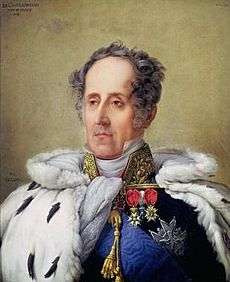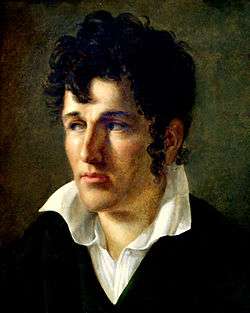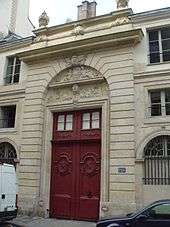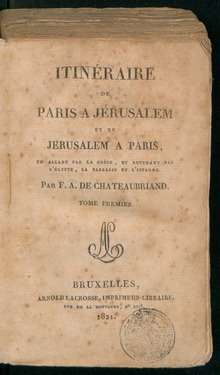François-René de Chateaubriand
| François-René de Chateaubriand OLH, KOESSH, KOSL, KOHS, KOSM | |
|---|---|
 Chateaubriand as a Peer of France (1828) | |
| French Ambassador to the Papal States | |
|
In office 4 January 1828 – 8 August 1829 | |
| Appointed by | Jean-Baptiste de Martignac |
| Preceded by | Adrien-Pierre de Montmorency-Laval |
| Succeeded by | Auguste de La Ferronays |
| Minister of Foreign Affairs | |
|
In office 28 December 1822 – 4 August 1824 | |
| Prime Minister | Jean-Baptiste de Villèle |
| Preceded by | Mathieu de Montmorency |
| Succeeded by | Hyacinthe Maxence de Damas |
| French Ambassador to the United Kingdom | |
|
In office 22 December 1822 – 28 December 1822 | |
| Appointed by | Jean-Baptiste de Villèle |
| Preceded by | Antoine de Gramont |
| Succeeded by | Jules de Polignac |
| French Ambassador to Prussia | |
|
In office 14 December 1821 – 22 December 1822 | |
| Appointed by | Jean-Baptiste de Villèle |
| Preceded by | Charles-François de Bonnay |
| Succeeded by | Maximilien Gérard de Rayneval |
| French Ambassador to Sweden | |
|
In office 3 April 1814 – 26 September 1815 | |
| Appointed by | Charles-Maurice de Talleyrand |
| Member of the Académie française | |
|
In office 1811–1848 | |
| Preceded by | Marie-Joseph Chénier |
| Succeeded by | Paul de Noailles |
| Personal details | |
| Born |
4 September 1768 Saint-Malo, Brittany, France |
| Died |
4 July 1848 (aged 79) Paris, Seine, France |
| Spouse(s) |
Céleste Buisson de la Vigne (m. 1792; her d. 1847) |
| Profession | Writer, translator, diplomat |
| Military service | |
| Allegiance |
|
| Service/branch | Armée des Émigrés |
| Years of service | 1792 |
| Rank | Private |
| Battles/wars | |
| Writing career | |
| Period | 19th century |
| Genre | Novel, memoir, essay |
| Subject | Religion, exoticism, existentialism |
| Literary movement |
Romanticism Conservatism |
| Notable works | |
| Years active | 1793–1848 |
| French literature |
|---|
| by category |
| French literary history |
| French writers |
|
| Portals |
|
| Part of a series on |
| Conservatism |
|---|
 |
|
Religious conservatism |
|
National variants |
|
François-René, vicomte de Chateaubriand (/ʃæˌtoʊbriːˈɑːn/;[1] French: [fʁɑ̃swa ʁəne də ʃɑtobʁijɑ̃]; 4 September 1768 – 4 July 1848), was a French writer, politician, diplomat and historian who founded Romanticism in French literature. Descended from an old aristocratic family from Brittany, Chateaubriand was a royalist by political disposition. In an age when a number of intellectuals turned against the Church, he authored the Génie du christianisme in defense of the Catholic faith. His works include the autobiography Mémoires d'Outre-Tombe ("Memoirs from Beyond the Grave"), published posthumously in 1849–1850.
Historian Peter Gay says that Chateaubriand saw himself as the greatest lover, the greatest writer, and the greatest philosopher of his age. Gay states that Chateaubriand "dominated the literary scene in France in the first half of the nineteenth century."[2]
Biography
Early years and exile

Born in Saint-Malo, the last of ten children, Chateaubriand grew up at his family's castle (the château de Combourg) in Combourg, Brittany. His father, René de Chateaubriand (1718–86), was a former sea captain turned ship owner and slave trader. His mother's maiden name was Apolline de Bedée. Chateaubriand's father was a morose, uncommunicative man, and the young Chateaubriand grew up in an atmosphere of gloomy solitude, only broken by long walks in the Breton countryside and an intense friendship with his sister Lucile. His youthful solitude and wild desire produced a suicide attempt with a hunting rifle, although the weapon failed to discharge.
Chateaubriand was educated in Dol, Rennes and Dinan. For a time he could not make up his mind whether he wanted to be a naval officer or a priest, but at the age of seventeen, he decided on a military career and gained a commission as a second lieutenant in the French Army based at Navarre. Within two years, he had been promoted to the rank of captain. He visited Paris in 1788 where he made the acquaintance of Jean-François de La Harpe, André Chénier, Louis-Marcelin de Fontanes and other leading writers of the time. When the French Revolution broke out, Chateaubriand was initially sympathetic, but as events in Paris became more violent he decided to journey to North America in 1791.[3] He was given the idea to leave Europe by Chrétien-Guillaume de Lamoigon de Malesherbes, who also encouraged him to do some botanical studies.[4]
Journey to America

In Voyage en Amérique, published in 1826, Chateaubriand writes that he arrived in Philadelphia on 10 July 1791. He visited New York, Boston and Lexington, before leaving by boat on the Hudson River to reach Albany.[5] He then followed the Mohawk trail up the Niagara Falls where he broke his arm and spent a month in recovery in the company of a Native American tribe. Chateaubriand then describes Native American tribes' customs, as well as zoological, political and economic consideration. He then says that a raid along the Ohio River, the Mississippi, Louisiana and Florida took him back to Philadelphia, where he embarked on the Molly in November to go back to France.[5]
This experience provided the setting for his exotic novels Les Natchez (written between 1793 and 1799 but published only in 1826), Atala (1801) and René (1802). His vivid, captivating descriptions of nature in the sparsely settled American Deep South were written in a style that was very innovative for the time and spearheaded what later became the Romantic movement in France. As early as 1916,[6] scholarship has cast doubt on Chateaubriand's claims that he was granted an interview with George Washington and that he actually lived for a time with the Native Americans he wrote about. Critics have questioned the veracity of entire sections of Chateaubriand's claimed travels, notably his passage through the Mississippi Valley, Louisiana and Florida.
Return to France
Chateaubriand returned to France in 1792 and subsequently joined the army of Royalist émigrés in Koblenz under the leadership of Louis Joseph de Bourbon, Prince of Condé. Under strong pressure from his family, he married a young aristocratic woman, also from Saint-Malo, whom he had never previously met, Céleste Buisson de la Vigne. In later life, Chateaubriand was notoriously unfaithful to her, having a series of love affairs. His military career came to an end when he was wounded at the siege of Thionville, a major clash between Royalist troops and the French Revolutionary Army. Half-dead, he was taken to Jersey and exiled to England, leaving his wife behind.
Exile in London
Chateaubriand spent most of his exile in extreme poverty in London, scraping a living offering French lessons and doing translation work, but a stay in Suffolk (Beccles) was more idyllic. Here Chateaubriand fell in love with a young English woman, Charlotte Ives, but the romance ended when he was forced to reveal he was already married. During his time in Britain, Chateaubriand also became familiar with English literature. This reading, particularly of John Milton's Paradise Lost (which he later translated into French prose), had a deep influence on his own literary work.
His exile forced Chateaubriand to examine the causes of the French Revolution, which had cost the lives of many of his family and friends; these reflections inspired his first work, Essai sur les Révolutions (1797). An attempt in 18th-century style to explain the French Revolution, it predated his subsequent, romantic style of writing and was largely ignored. A major turning point in Chateaubriand's life was his conversion back to the Catholic faith of his childhood around 1798.
Consulate and Empire
Chateaubriand took advantage of the amnesty issued to émigrés to return to France in May 1800 (under the French Consulate); Chateaubriand edited the Mercure de France. In 1802, he won fame with Génie du christianisme ("The Genius of Christianity"), an apology for the Catholic Christian faith which contributed to the post-revolutionary religious revival in France. It also won him the favour of Napoleon Bonaparte, who was eager to win over the Catholic Church at the time.
James McMillan argues that a Europe-wide Catholic Revival emerged from the change in intellectual climate from intellectually oriented classicism to emotionally based romanticism. He concludes that Chateaubriand’s book:
- did more than any other single work to restore the credibility and prestige of Christianity in intellectual circles and launched a fashionable rediscovery of the Middle Ages and their Christian civilisation. The revival was by no means confined to an intellectual elite, however, but was evident in the real, if uneven, rechristianisation of the French countryside.[7]
Appointed secretary of the legation to the Holy See by Napoleon, he accompanied Cardinal Fesch to Rome. But the two men soon quarrelled and Chateaubriand was nominated as minister to Valais (in Switzerland). He resigned his post in disgust after Napoleon ordered the execution in 1804 of Louis XVI's cousin, Louis-Antoine-Henri de Bourbon-Condé, duc d'Enghien. Chateaubriand was, after his resignation, completely dependent on his literary efforts. However, and quite unexpectedly, he received a large sum of money from the Russian Tsarina Elizabeth Alexeievna. She had seen him as a defender of Christianity and thus worthy of her royal support.
Chateaubriand used his new-found wealth in 1806 to visit Greece, Asia Minor, Palestine, Egypt, Tunisia and Spain. The notes he made on his travels later formed part of a prose epic, Les Martyrs, set during the Roman persecution of early Christianity. His notes also furnished a running account of the trip itself, published in 1811 as the Itinéraire de Paris à Jérusalem (Itinerary from Paris to Jerusalem). The Spanish stage of the journey inspired a third novella, Les aventures du dernier Abencérage (The Adventures of the Last Abencerrage), which appeared in 1826.
On his return to France, he published a severe criticism of Napoleon, comparing him to Nero and predicting the emergence of a new Tacitus. Napoleon famously threatened to have Chateaubriand sabered on the steps of the Tulieries Palace for it, but settled for merely banishing him from the city. Chateaubriand retired to a modest estate he called La Vallée aux Loups ("Wolf Valley"), in Châtenay-Malabry, 11 km (6.8 mi) south of central Paris. Here he finished Les Martyrs, which appeared in 1809, and began the first drafts of his memoirs. He was elected to the Académie française in 1811, but, given his plan to infuse his acceptance speech with criticism of the Revolution, he could not occupy his seat until after the Bourbon Restoration. His literary friends during this period included Madame de Staël, Joseph Joubert and Pierre-Simon Ballanche.
Under the Restoration
He became a major figure in politics as well as literature. At first he was a strong Royalist in the period up to 1824. His liberal phase lasted from 1824 to 1830. After that he was much less active. After the fall of Napoleon, Chateaubriand rallied to the Bourbons. On 30 March 1814, he wrote a pamphlet against Napoleon, titled De Buonaparte et des Bourbons, of which thousands of copies were published. He then followed Louis XVIII into exile to Ghent during the Hundred Days (March–July 1815), and was nominated ambassador to Sweden.
After Napoleon's final defeat, Chateaubriand became peer of France and state minister (1815). In December 1815 he voted for Marshal Ney's execution. However, his criticism of King Louis XVIII in La Monarchie selon la Charte, after the Chambre introuvable was dissolved, got him disgraced. He lost his function of state minister, and joined the opposition, siding with the Ultra-royalist group supporting the future Charles X, and becoming one of the main writers of its mouthpiece, Le Conservateur.
Chateaubriand sided again with the Court after the murder of the Duc de Berry (1820), writing for the occasion the Mémoires sur la vie et la mort du duc. He then served as ambassador to Prussia (1821) and the United Kingdom (1822), and even rose to the office of Minister of Foreign Affairs (28 December 1822 – 4 August 1824). A plenipotentiary to the Congress of Verona (1822), he decided in favor of the Quintuple Alliance's intervention in Spain during the Trienio Liberal, despite opposition from the Duke of Wellington. Although the move was considered a success, Chateaubriand was soon relieved of his office by Prime Minister Jean-Baptiste de Villèle, the leader of the ultra-royalist group, on 5 June 1824.
Consequently, he moved towards the liberal opposition, both as a Peer and as a contributor to Journal des Débats (his articles there gave the signal of the paper's similar switch, which, however, was more moderate than Le National, directed by Adolphe Thiers and Armand Carrel). Opposing Villèle, he became highly popular as a defender of press freedom and the cause of Greek independence. After Villèle's downfall, Charles X appointed him ambassador to the Holy See in 1828, but he resigned upon the accession of the Prince de Polignac as premier (November 1829).
In 1830, he donated a monument to the French painter Nicolas Poussin in the church of "San Lorenzo in Lucina" in Rome.
July Monarchy

In 1830, after the July Revolution, his refusal to swear allegiance to the new House of Orléans king Louis-Philippe put an end to his political career. He withdrew from political life to write his Mémoires d'Outre-Tombe ("Memoirs from Beyond the Grave"), published posthumously in two volumes in 1849–1850. It reflects his growing pessimism regarding the future. Although his contemporaries celebrated the present and future as an extension of the past, Chateaubriand and the new Romanticists abandoned this nostalgic outlook. Instead he foresaw chaos, discontinuity, and disaster. His diaries and letters often focused on the upheavals he could see every day--abuses of power, excesses of daily life, and disasters yet to come. His melancholy tone suggested astonishment, surrender, betrayal, and bitterness.[8][9]
His Études historiques was an introduction to a projected History of France. He became a harsh critic of the "bourgeois king" and the July Monarchy, and his planned volume on the arrest of the duchesse de Berry caused him to be unsuccessfully prosecuted.
Chateaubriand, along with other Catholic traditionalists such as Ballanche or, on the other side of the political divide, the socialist and republican Pierre Leroux, was one of the few of his time who attempted to conciliate the three terms of Liberté, égalité and fraternité, going beyond the antagonism between liberals and socialists as to what interpretation to give the seemingly contradictory terms.[10] Chateaubriand thus gave a Christian interpretation of the revolutionary motto, stating in the 1841 conclusion to his Mémoires d'Outre-Tombe:
Far from being at its term, the religion of the Liberator is now only just entering its third phase, the political period, liberty, equality, fraternity.[10][11]
In his final years, he lived as a recluse in an apartment at 120 rue du Bac, Paris, leaving his house only to pay visits to Juliette Récamier in Abbaye-aux-Bois. His final work, Vie de Rancé, was written at the suggestion of his confessor and published in 1844. It is a biography of Armand Jean le Bouthillier de Rancé, a worldly seventeenth-century French aristocrat who withdrew from society to become the founder of the Trappist order of monks. The parallels with Chateaubriand's own life are striking. Chateaubriand died in Paris during the Revolution of 1848 and was buried, as he had requested, on the tidal island Grand Bé near Saint-Malo, accessible only when the tide is out.
Influence
His descriptions of Nature and his analysis of emotion made him the model for a generation of Romantic writers, not only in France but also abroad. For example, Lord Byron was deeply impressed by René. The young Victor Hugo scribbled in a notebook, "To be Chateaubriand or nothing." Even his enemies found it hard to avoid his influence. Stendhal, who despised him for political reasons, made use of his psychological analyses in his own book, De l'amour.
Chateaubriand was the first to define the vague des passions ("intimations of passion") that later became a commonplace of Romanticism: "One inhabits, with a full heart, an empty world" (Génie du Christianisme). His political thought and actions seem to offer numerous contradictions: he wanted to be the friend both of legitimist royalty and of republicans, alternately defending whichever of the two seemed more in danger: "I am a Bourbonist out of honour, a monarchist out of reason, and a republican out of taste and temperament". He was the first of a series of French men of letters (Lamartine, Victor Hugo, André Malraux, Paul Claudel) who tried to mix political and literary careers.
"We are convinced that the great writers have told their own story in their works", wrote Chateaubriand in Génie du christianisme. "One only truly describes one's own heart by attributing it to another, and the greater part of genius is composed of memories". This is certainly true of Chateaubriand himself. All his works have strong autobiographical elements, overt or disguised.
George Brandes, in 1901, compared the works of Chateaubriand to those of Rousseau and others:
The year 1800 was the first to produce a book bearing the imprint of the new era, a work small in size, but great in significance and mighty in the impression it made. Atala took the French public by storm in a way which no book had done since the days of Paul and Virginia. It was a romance of the plains and mysterious forests of North America, with a strong, strange aroma of the untilled soil from which it sprang; it glowed with rich foreign colouring, and with the fiercer glow of consuming passion.[12]
Chateaubriand was a food enthusiast; Chateaubriand steak is most likely to have been named after him.[13]
Honors and memberships
Chateaubriand was elected a member of the American Antiquarian Society in 1816.[14]
Works

- 1797: Essai sur les révolutions.
- 1801: Atala, ou Les Amours de Deux Sauvages dans le Desert.
- 1802: René.
- 1802: Génie du christianisme.
- 1809: Les Martyrs.
- 1811: Itinéraire de Paris à Jérusalem. English translation by Frederic Shoberl, 1814. Travels in Greece, Palestine, Egypt, and Barbary, during the years 1806 and 1807.
- 1814: "On Buonaparte and the Bourbons", in Blum, Christopher Olaf, editor and translator, 2004. Critics of the Enlightenment. Wilmington, DE: ISI Books. 3–42.
- 1820: Mémoires sur la vie et la mort du duc de Berry.
- 1826: Les Natchez.
- 1826: Les Aventures du dernier Abencérage.
- 1827: Voyage en Amérique.
- 1831: Études historiques.
- 1833: Mémoires sur la captivité de Madame la duchesse de Berry.
- 1844: La Vie de Rancé.
- 1848–50. Mémoires d'Outre-Tombe.
- "Progress," in Menczer, Béla, 1962. Catholic Political Thought, 1789–1848, University of Notre Dame Press.
Digitized works
- [Opere]. 1.
- Génie du Cristianisme.
- [Opere]. 2.
- Itinéraire de Paris a Jérusalem et de Jérusalem a Paris.
- Martyrs.
- Voyage en Amérique.
- Mélanges politiques.
- Polémique.
- Études historiques.
- Analyse raisonnée de l'histoire de la France.
- Paradise lost.
- Congrès de Verone.
- Mémoires d'outre-tombe. 1.
- Mémoires d'outre-tombe. 2.
- Mémoires d'outre-tombe. 3.
- Mémoires d'outre-tombe. 4.
- Mémoires d'outre-tombe. 5.
- Mémoires d'outre-tombe. 6.
- Dernières années de Chateaubriand.
See also
Notes
- ↑ "Chateaubriand". Random House Webster's Unabridged Dictionary.
- ↑ Peter Gay, "The Complete Romantic," Horizon (1966) 8#2 pp 12-19.
- ↑ Nitze, William A. "Chateaubriand in America", The Dial, Vol. LXV, June–December 1918.
- ↑ Tapié, V.-L. (1965) Chateaubriand. Seuil.
- 1 2 Chateaubriand, F-R. (1826) Voyage en Amérique
- ↑ Lebègue, R. (1965) Le problème du voyage de Chateaubriand en Amérique. Journal des Savants, 1,1 from http://www.persee.fr/web/revues/home/prescript/article/jds_0021-8103_1965_num_1_1_1104
- ↑ James McMillan, "Catholic Christianity in France from the Restoration to the separation of church and state, 1815-1905." in Sheridan Gilley and Brian Stanley, eds., The Cambridge history of Christianity (2014) 8: 217-232
- ↑ Peter Fritzsche, "Chateaubriand's Ruins: Loss and Memory after the French Revolution." History and Memory 10.2 (1998): 102-117. online
- ↑ Peter Fritzsche, "Specters of history: On nostalgia, exile, and modernity." American Historical Review 106.5 (2001): 1587-1618.
- 1 2 Mona Ozouf, "Liberté, égalité, fraternité", in Lieux de Mémoire (dir. Pierre Nora), tome III, Quarto Gallimard, 1997, pp.4353–4389 (in French) (abridged translation, Realms of Memory, Columbia University Press, 1996–1998 (in English))
- ↑ French: "Loin d'être à son terme, la religion du Libérateur entre à peine dans sa troisième période, la période politique, liberté, égalité, fraternité.
- ↑ George Brandes, Main Currents in Nineteenth Century Literature, 1:The Emigrant Literature p. 7
- ↑ see the Chateaubriand steak article for discussion
- ↑ American Antiquarian Society Members Directory
References

- Marc Fumaroli, Chateaubriand: poésie et terreur, Fallois, Paris: 2004.



Further reading
- Counter, Andrew J. "A Nation of Foreigners: Chateaubriand and Repatriation." Nineteenth-Century French Studies 46.3 (2018): 285-306. online
- Painter, George D. Chateaubriand: A Biography: Volume I (1768–93) The Longed-For Tempests. (1997) online review
- Rosenthal, Léon, and Marc Sandoz. "Chateaubriand, Francois-Auguste-Rene, Vicomte De 1768–1848." in Encyclopedia of the Romantic Era, 1760–1850 (2013): 168.
- Scott, Malcolm. Chateaubriand: The Paradox of Change (Peter Lang, 2015). vi + 216 pp. online review
- Thompson, Christopher W. French romantic travel writing: Chateaubriand to Nerval (Oxford University Press, 2012).
In French
- Ghislain de Diesbach, Chateaubriand (Paris: Perrin, 1995).
- Jean-Claude Berchet, Chateaubriand (Paris: Gallimard, 2012).
Primary sources
- de Chateaubriand, François-René. Chateaubriand's Travels in America. (University Press of Kentucky, 2015).
- Chateaubriand, François-René. The genius of Christianity (1884). online
- Chateaubriand, François-René. Travels in Greece, Palestine, Egypt and Barbary: during the years 1806 and 1807 (1814). online
- Chateaubriand's works were edited in 20 volumes by Sainte-Beuve, with an introductory study of his own (1859–60).
External links
- Works by François Auguste de Chateaubriand at Project Gutenberg
- Works by François-René Chateaubriand at Project Gutenberg
- Works by or about François-René de Chateaubriand at Internet Archive
- Works by François-René de Chateaubriand at LibriVox (public domain audiobooks)

- Maison de Chateaubriand à la Vallée-aux-Loups
- (in French) Atala, René, Le Dernier Abencerage at athena.unige.ch
- (in French) Works in digital reading
- (in English) Mémoires d'Outre-Tombe at Poetry in Translation: a complete English translation of the Memoirs by A. S. Kline, with a hyper-linked in-depth index and over 600 illustrations of the people, places and events of Chateaubriand's life. Retrieved 27 August 2015.
- (in French) Complete works
- Bibliowiki has original media or text related to this article: François-René de Chateaubriand (in the public domain in Canada)
